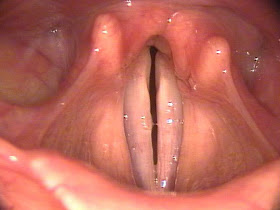
Bilateral Vocal Cord Paralysis:
In contrast to unilateral vocal cord paralysis, voice quality is not the primary concern in patients with bilateral vocal cord paralysis. The significant problem is airway compromise. This can range from unnoticeable to, more commonly, dyspnea and stridor. The patient's voice quality is usually only mildly affected (if just the recurrent laryngeal nerves are invulved) because the paralyzed cords tend to assume the natural position for phonation.
There are three basic ways that bilateral vocal cord paralysis is managed:
1) tracheotomy
2) vocal cord lateralization
3) reinnervation
Vocal Cord Lateralization:
This invulves several techniques that surgically widen the glottic opening. While this improves the airway, the patient's voice quality suffers. The three most commonly utilized techniques are arytenoidectomy, arytenoidopexy, and cordectomy.
Arytenoidopexy:(Dr Janaki Ram)
Invulves displacing the vocal fold and arytenoid without surgical removal of any tissue. It can be done endoscopically with a suture passed around the vocal process of the arytenoid and secured laterally.
Watch Laser Arytenoidectomy Surgery For Bilateral Vocal Fold Paralysis: Dr Nupur(Mumbai)
the whole text has been copied from UTMB grand rounds
ReplyDeleteThe blog is compilation of information available on net. We don't claim it as original writing.
ReplyDelete